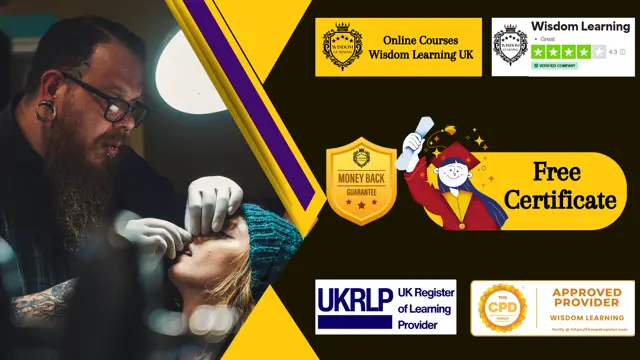
Anatomy and Physiology in Body Piercing
UKRLP & CPD approved provider | Easy Refund | Free e-Certificate | Instant Access | Tutor Support |
Wisdom Learning Limited
Summary
- Reed Courses Certificate of Completion - Free
- Tutor is available to students
Add to basket or enquire
Overview
Anatomy and Physiology in Body Piercing
The Anatomy and Physiology in Body Piercing course offers a comprehensive exploration of human anatomy essential for safe and successful piercing practices. Delving into skin layers, vascular and nervous systems, and immune responses, students gain a deep understanding of how the body interacts with body piercing. From recognising anatomical variations to mastering aftercare techniques and managing complications, this Anatomy and Physiology in Body Piercing course equips aspiring professionals with vital skills. Designed for individuals pursuing a career in body piercing within the UK, it ensures compliance with regulatory standards while fostering ethical conduct and professional development. Join us to unlock the knowledge needed to excel in this dynamic and rewarding field of Body Piercing.
Key Features- Anatomy and Physiology in Body Piercing
This Anatomy and Physiology in Body Piercing includes the following offers:
- Anatomy and Physiology in Body Piercing - Instant Free Certificates
- Self-paced learning
- 24/7 Support
Enrol on our Anatomy and Physiology in Body Piercing course to gain a comprehensive understanding of Anatomy and Physiology in Body Piercing.
Certificates
Reed Courses Certificate of Completion
Digital certificate - Included
Will be downloadable when all lectures have been completed.
Curriculum
-
Lesson 1: Skin and Tissue Layers 06:00
-
Lesson 2: Anatomy of Common Piercing Locations 07:00
-
Lesson 3: Vascular and Nervous Systems 05:00
-
Lesson 4: Immune and Healing Responses 06:00
-
Lesson 5: Lymphatic System and Aftercare 06:00
-
Lesson 6: Allergic Reactions and Sensitivities 05:00
-
Lesson 7: Anatomical Considerations in Genital Piercings 05:00
-
Lesson 8: Anatomical Variations and Special Cases 06:00
-
Lesson 9: Complications and Troubleshooting 06:00
-
Lesson 10: Case studies to apply different piercing scenarios 02:00
-
Lesson 11: First-aid skills for piercing professionals 02:00
-
Lesson 12: Organisations and governmental entities in the UK related to piercing 02:00
Course media
Description
Anatomy and Physiology in Body Piercing
Upon completion of this Anatomy and Physiology in Body Piercing course, participants will:
Understand Skin and Tissue Layers: Grasp the structure of the skin, including the epidermis, dermis, and subcutaneous tissue, and comprehend how skin composition influences the piercing process and healing.
Analyse the Anatomy of Common Piercing Locations: Explore the anatomical intricacies of common piercing sites such as the ear, face, and body, considering variations in anatomy and their implications for piercing placement.
Assess Vascular and Nervous Systems: blood vessels and nerve distributions in the skin, crucial for minimising bleeding risks and managing pain perception during piercing procedures.
Evaluate Immune and Healing Responses: Understand the immune system's role in healing, the body's responses to trauma and foreign objects.
Apply Lymphatic System Knowledge in Aftercare: Implement aftercare practices that support the lymphatic system.
Differentiate Allergic Reactions and Sensitivities: Distinguish between allergies and sensitivities, recognise common jewellery materials that may trigger reactions.
Navigate Anatomical Considerations in Genital Piercings: Communicate sensitively with clients, understand detailed genital anatomy.
Adapt Techniques for Anatomical Variations and Special Cases: Recognize unique anatomical variations among clients.
Recognise and Address Complications: Identify signs of piercing complications, understand how anatomy influences their development.
Apply Anatomical Knowledge in Case Studies
Acquire First-Aid Skills for Piercing Professionals
Navigate Regulatory Frameworks and Professional Standards in the UK
How This Anatomy and Physiology in Body Piercing Course Can Help (UK)
In the UK, where body piercing is subject to regulation and oversight, this Anatomy and Physiology in Body Piercing course offers invaluable knowledge and skills for aspiring and practicing piercers:
Compliance with Regulatory Standards
Enhanced Client Safety and Satisfaction
Professional Development and Recognition
Reduced Risk of Complications
Expanded Career Opportunities
Anatomy and Physiology in Body Piercing Certificate
Upon completing the Anatomy and Physiology in Body Piercing Course, you will receive an instant Anatomy and Physiology in Body Piercing certificate from Reed.
Who is this course for?
Anatomy and Physiology in Body Piercing
This Anatomy and Physiology in Body Piercing course is designed for individuals aspiring to pursue a career in body piercing, including:
Requirements
Anatomy and Physiology in Body Piercing
- Learners with no prior Anatomy and Physiology in Body Piercing knowledge may enrol in this Anatomy and Physiology in Body Piercing course.
- This Anatomy and Physiology in Body Piercing course has no requirements.
Career path
Anatomy and Physiology in Body Piercing
ANATOMY AND PHYSIOLOGY IN BODY PIERCING training offers a unique opportunity to gain valuable skills and advance your career
Questions and answers
Currently there are no Q&As for this course. Be the first to ask a question.
Reviews
Currently there are no reviews for this course. Be the first to leave a review.
Legal information
This course is advertised on Reed.co.uk by the Course Provider, whose terms and conditions apply. Purchases are made directly from the Course Provider, and as such, content and materials are supplied by the Course Provider directly. Reed is acting as agent and not reseller in relation to this course. Reed's only responsibility is to facilitate your payment for the course. It is your responsibility to review and agree to the Course Provider's terms and conditions and satisfy yourself as to the suitability of the course you intend to purchase. Reed will not have any responsibility for the content of the course and/or associated materials.


